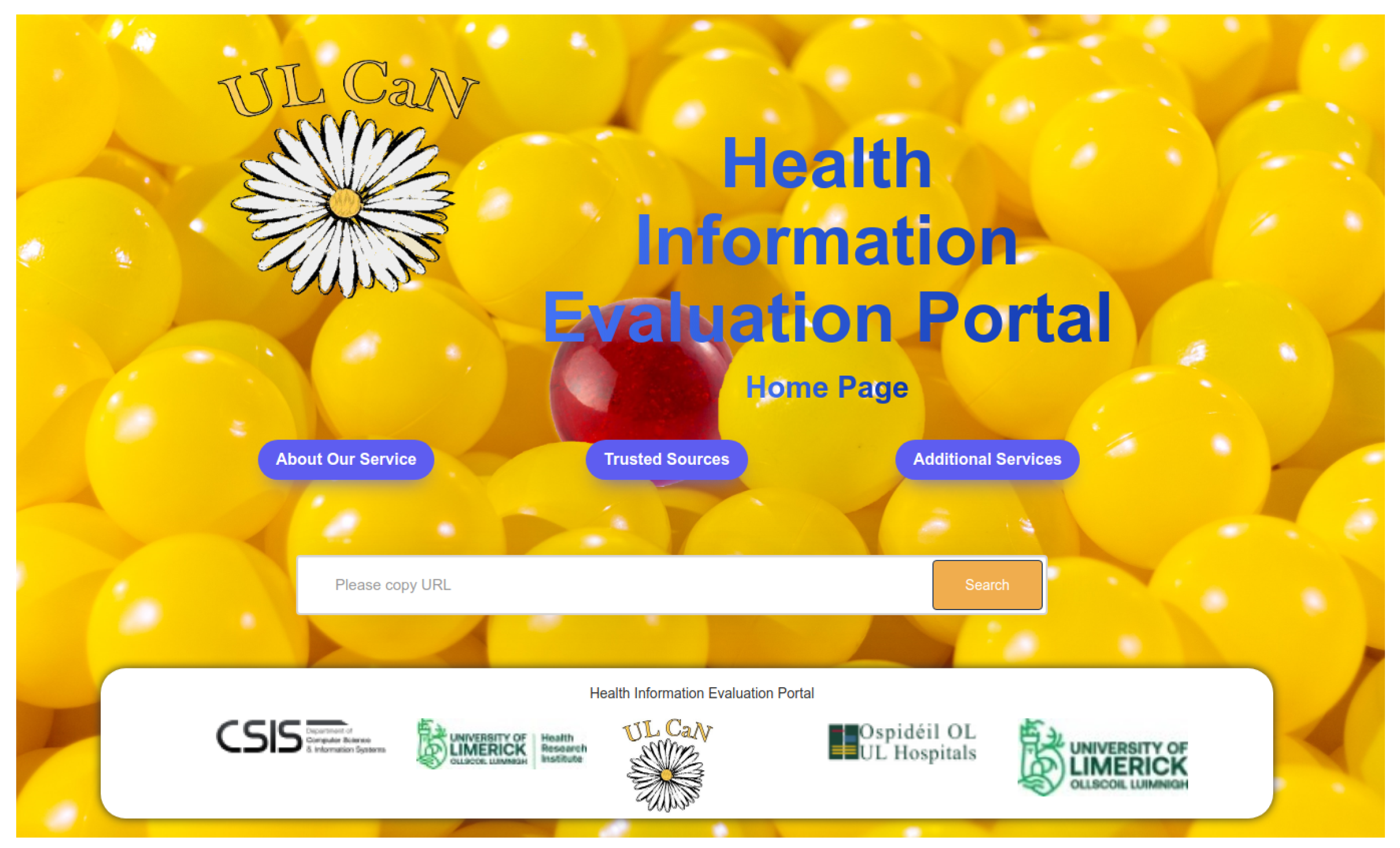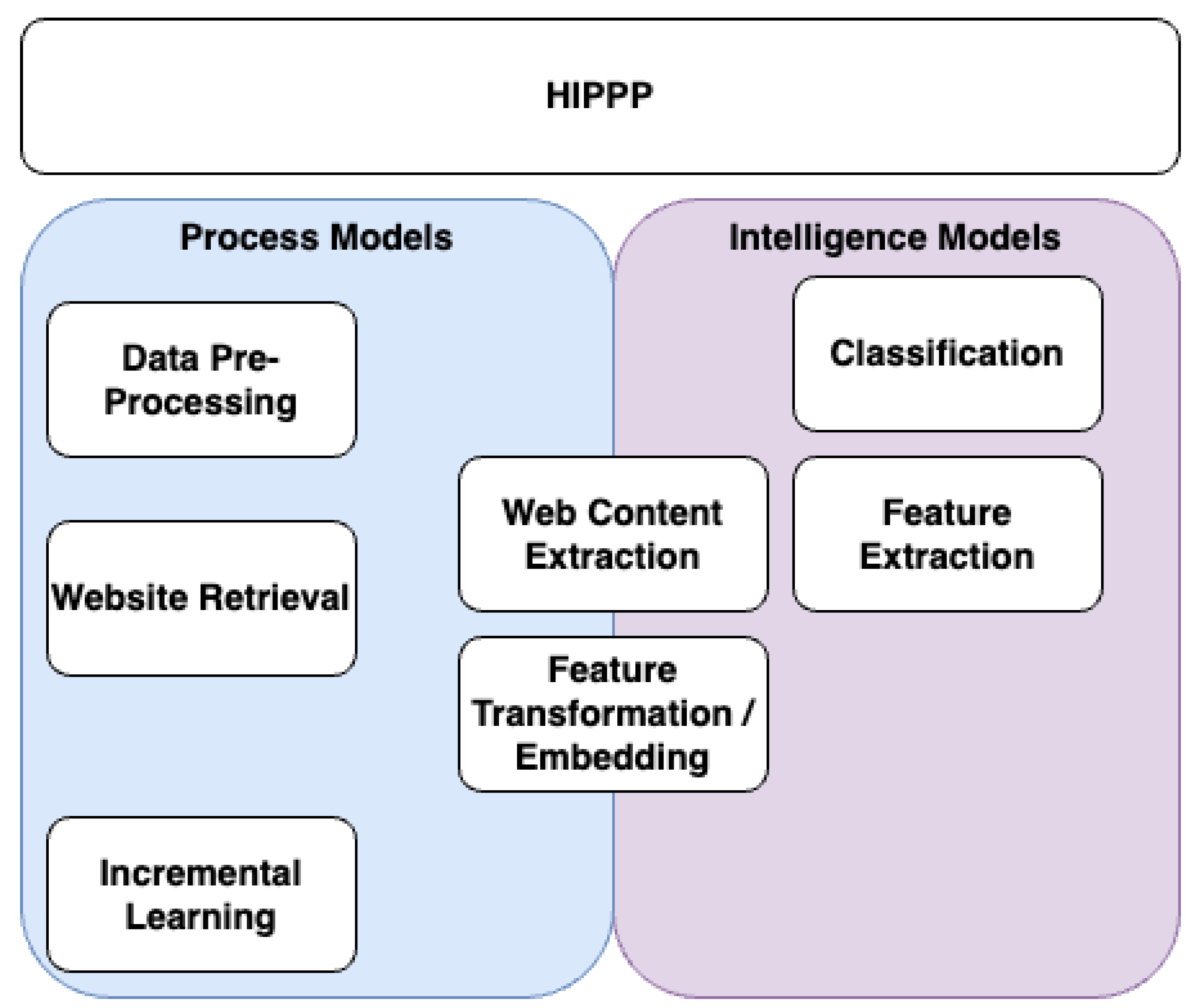HIPPP: Health Information Portal for Patients and Public
Abstract
:1. Introduction
- With respect to domain-specific languages for health and medical research support, our contribution is the extension of the DIME platform through the creation of a GDSL and integration of the accompanying set of services for that GDSL, which will in future enable health and medical researchers to develop their own equivalent web application or be much more integrated into the design and development process.
- Pertaining to data management cycle for integration and longer reuse, the HIPPP user-facing application will serve as a crowd-sourcing tool. With the acquired data (i.e., the user-provided web-pages) being stored to support future uses. The primary use being to improve the applications’ performance through human-in-the-loop incremental learning, however, it could also serve the function of giving researchers insight into what health information sources patients and the public use.
- In the context of technologies for the evolution and customisation of IT platforms for health, due to the co-design element of the HIPPP project, we were able to encapsulate concepts familiar to those working in the healthcare and medical domain to customise the web application to meet the requirements and expectations of medical domain researchers.
2. Materials: The HIPPP IT System for PPI
2.1. The HIPPP Web-Based Application
2.2. HIPPP-AI: The Evaluation Pipeline Environment
2.2.1. Website Retrieval
2.2.2. Web Content Extraction
2.2.3. Data Pre-Processing
2.2.4. Feature Extraction
2.2.5. Feature Transformation/Embedding
2.2.6. Classification
2.2.7. Incremental Learning
3. Methods
3.1. Model Driven Development
3.1.1. Graphical User Interface (GUI) Modelling
3.1.2. Process Modelling
3.1.3. Data Modelling
3.2. AI—Model Driven Development
3.2.1. Development of Process Models
Development of Intelligent Process Models
Data Collection and Labelling Methods
Feature Extraction/Engineering
3.2.2. Incremental Learning
3.2.3. Orchestration
3.2.4. Implementation of Pipeline Components
4. Results and Validation Approach
4.1. Web Application and User Interface
4.2. Evaluation Pipeline
- Empirical evaluation of the pipeline output following ML model evaluation best practices. Here, each ML component will be evaluated using a testing regime, which will assess the models with respect to classification accuracy, robustness, interpretability of output and reproducibility of results. All models will be tested on labelled data sets previously unseen by the models (i.e., not used during model training or validation). A range of statistical tests will also be carried out along with in-variance tests, directional expectation tests and minimum functionality tests.
- Validation of training data collection processes through PPI groups. Once we conclude the first phase of data collection and base model building, the training data collection process will be validated through PPI groups. The aim is to get feedback on the kind of WBHI channels through which people access information in order to ensure that there is good coverage for these types of channels in the training data. Subsequent PPI group meetings will help validate how the classifications are displayed and ensure maximum comprehensibility of the evaluation for the target audience.
4.2.1. Time Efficiency Study
Experimental Setup
Experimental Findings
5. Discussion
5.1. HIPPP Web App and Reusability
5.2. Evaluation Pipeline
5.3. Contributions
- Regarding domain-specific languages (DSLs) for health and medical research support, our contribution involves expanding the capabilities of the DIME platform. This expansion involved creating a GDSL and integrating a corresponding set of services for that GDSL. This enhancement to DIME’s modelling capability will enable health and medical researchers to develop their own web applications or seamlessly integrate them into the design and development process of such applications more effectively.
- Concerning the data management cycle for integration and long-term reuse, the HIPPP user-facing application will function as a crowd-sourcing tool. It will collect user-provided web pages, storing them for future utilisation. The primary purpose is to enhance the application’s performance through incremental learning with human input. Additionally, it can provide researchers with insights into the health information sources used by patients and the general public.
- In terms of technologies for the evolution and customisation of IT platforms for health, the HIPPP project incorporates a substantial co-design element. This approach enabled us to incorporate familiar concepts from the healthcare and medical domain into the system, tailoring the system to meet the specific requirements and expectations of stakeholders from the medical and health domain.
5.4. Next Steps
Author Contributions
Funding
Institutional Review Board Statement
Informed Consent Statement
Data Availability Statement
Conflicts of Interest
References
- Battineni, G.; Baldoni, S.; Chintalapudi, N.; Sagaro, G.G.; Pallotta, G.; Nittari, G.; Amenta, F. Factors affecting the quality and reliability of online health information. Digit. Health 2020, 6, 2055207620948996. [Google Scholar] [CrossRef] [PubMed]
- Frequency of Internet Usage-CSO-Central Statistics Office. Available online: https://www.cso.ie/en/releasesandpublications/ep/p-isshh/informationsocietystatistics-households2019/typeofinternetactivities/ (accessed on 1 June 2023).
- Fong, T.; Wang-Gillam, A.; Waqar, M.A.; Jeffe, D.B.; Kehlenbrink, L.; Gao, F.; Govindan, R. A survey of Internet utilization among patients with cancer. Support. Care Cancer 2011, 19, 1183–1190. [Google Scholar] [CrossRef]
- Taioli, E.; Joseph, G.R.; Robertson, L.; Eckstein, S.; Ragin, C. Knowledge and prevention practices before breast cancer diagnosis in a cross-sectional study among survivors: Impact on patients’ involvement in the decision making process. J. Cancer Educ. 2014, 29, 44–49. [Google Scholar] [CrossRef] [PubMed]
- Silberg, W.M.; Lundberg, G.D.; Musacchio, R.A. Assessing, Controlling, and Assuring the Quality of Medical Information on the Internet: Caveant Lector et Viewor—Let the Reader and Viewer Beware. JAMA 1997, 277, 1244–1245. [Google Scholar] [CrossRef] [PubMed]
- Charnock, D.; Shepperd, S.; Needham, G.; Gann, R. DISCERN: An instrument for judging the quality of written consumer health information on treatment choices. J. Epidemiol. Community Health 1999, 53, 105–111. [Google Scholar] [CrossRef] [PubMed]
- Boyer, C.; Selby, M.; Scherrer, J.R.; Appel, R. The Health On the Net Code of Conduct for medical and health Websites. Comput. Biol. Med. 1998, 28, 603–610. [Google Scholar] [CrossRef] [PubMed]
- Cuan-Baltazar, J.Y.; Muñoz-Perez, M.J.; Robledo-Vega, C.; Pérez-Zepeda, M.F.; Soto-Vega, E. Misinformation of COVID-19 on the internet: Infodemiology study. JMIR Public Health Surveill. 2020, 6, e18444. [Google Scholar] [CrossRef] [PubMed]
- Robillard, J.M.; Jun, J.H.; Lai, J.A.; Feng, T.L. The QUEST for quality online health information: Validation of a short quantitative tool. BMC Med. Inform. Decis. Mak. 2018, 18, 87. [Google Scholar] [CrossRef] [PubMed]
- van de Ven, G.M.; Tuytelaars, T.; Tolias, A.S. Three types of incremental learning. Nat. Mach. Intell. 2022, 4, 1185–1197. [Google Scholar] [CrossRef] [PubMed]
- Margaria, T.; Steffen, B. Extreme model-driven development (xmdd) technologies as a hands-on approach to software development without coding. In Encyclopedia of Education and Information Technologies; Springer: Berlin/Heidelberg, Germany, 2020; pp. 732–750. [Google Scholar]
- Norman, D. The Design of Everyday Things: Revised and Expanded Edition; Basic Books: New York, NY, USA, 2013. [Google Scholar]
- WAI. Accessibility, Usability, and Inclusion; WAI: Wakefield, MA, USA, 2010. [Google Scholar]
- Prieto, V.M.; Alvarez, M.; Cacheda, F. Analysis and detection of Soft-404 pages. In Proceedings of the 2013 3rd International Conference on Innovative Computing Technology, INTECH 2013, London, UK, 29–31 August 2013; pp. 217–226. [Google Scholar] [CrossRef]
- Kinkead, L.; Allam, A.; Krauthammer, M. Autodiscern: Rating the quality of online health information with hierarchical encoder attention-based neural networks. BMC Med. Inform. Decis. Mak. 2020, 20, 104. [Google Scholar] [CrossRef] [PubMed]
- Joury, A.; Joraid, A.; Alqahtani, F.; Alghamdi, A.; Batwa, A.; Pines, J.M. The variation in quality and content of patient-focused health information on the Internet for otitis media. Child Care Health Dev. 2018, 44, 221–226. [Google Scholar] [CrossRef] [PubMed]
- Arif, N.; Ghezzi, P. Quality of online information on breast cancer treatment options. Breast 2018, 37, 6–12. [Google Scholar] [CrossRef] [PubMed]
- Torrey, L.; Shavlik, J. Transfer learning. In Handbook of Research on Machine Learning Applications and Trends: Algorithms, Methods, and Techniques; IGI Global: Hershey, PA, USA, 2010; pp. 242–264. [Google Scholar]
- Boßelmann, S.; Neubauer, J.; Naujokat, S.; Steffen, B. Model-driven design of secure high assurance systems: An introduction to the open platform from the user perspective. In Proceedings of the 2016 International Conference on Security and Management (SAM 2016), Las Vegas, NV, USA, 25–28 July 2016; pp. 145–151. [Google Scholar]
- Merkel, D. Docker: Lightweight linux containers for consistent development and deployment. Linux J. 2014, 2014, 2. [Google Scholar]
- Minin, H.C.; Alemán, J.J.; Sacramento, C.; Trevisan, D.G. A WYSIWYG editor to support accessible web content production. In Proceedings of the International Conference on Universal Access in Human-Computer Interaction, Los Angeles, CA, USA, 2–7 August 2015; Springer: Berlin/Heidelberg, Germany, 2015; pp. 221–230. [Google Scholar]
- Amershi, S.; Begel, A.; Bird, C.; DeLine, R.; Gall, H.; Kamar, E.; Nagappan, N.; Nushi, B.; Zimmermann, T. Software Engineering for Machine Learning: A Case Study. In Proceedings of the 2019 IEEE/ACM 41st International Conference on Software Engineering: Software Engineering in Practice, ICSE-SEIP 2019, Montreal, QC, Canada, 25–31 May 2019; pp. 291–300. [Google Scholar] [CrossRef]
- Barbaresi, A. Trafilatura: A Web Scraping Library and Command-Line Tool for Text Discovery and Extraction. In Proceedings of the Joint Conference of the 59th Annual Meeting of the Association for Computational Linguistics and the 11th International Joint Conference on Natural Language Processing: System Demonstrations, Bangkok, Thailand, 1–6 August 2021; Association for Computational Linguistics: Stroudsburg, PA, USA, 2021; pp. 122–131. [Google Scholar]
- Abadi, M.; Agarwal, A.; Barham, P.; Brevdo, E.; Chen, Z.; Citro, C.; Corrado, G.S.; Davis, A.; Dean, J.; Devin, M.; et al. TensorFlow: Large-scale machine learning on heterogeneous systems. arXiv 2016, arXiv:1603.04467. [Google Scholar]
- Pedregosa, F.; Varoquaux, G.; Gramfort, A.; Michel, V.; Thirion, B.; Grisel, O.; Blondel, M.; Prettenhofer, P.; Weiss, R.; Dubourg, V.; et al. Scikit-learn: Machine Learning in Python. J. Mach. Learn. Res. 2011, 12, 2825–2830. [Google Scholar]
- Bird, S. NLTK: The natural language toolkit. In Proceedings of the COLING/ACL 2006 Interactive Presentation Sessions, Sydney, Australia, 17–18 July 2006. [Google Scholar]
- Chaudhary, H.A.A.; Margaria, T. Integration of micro-services as components in modeling environments for low code development. Труды Института системнoгo прoграммирoвания РАН 2021, 33, 19–30. [Google Scholar] [CrossRef] [PubMed]
- Yardley, L.; Morrison, L.; Bradbury, K.; Muller, I. The person-based approach to intervention development: Application to digital health-related behavior change interventions. J. Med. Internet Res. 2015, 17, e4055. [Google Scholar] [CrossRef] [PubMed]
- Wang, Q.; Fang, Y.; Ravula, A.; Feng, F.; Quan, X.; Liu, D. Webformer: The web-page transformer for structure information extraction. In Proceedings of the ACM Web Conference, Lyon, France, 25–29 April 2022; pp. 3124–3133. [Google Scholar]
- Zhou, Y.; Sheng, Y.; Vo, N.; Edmonds, N.; Tata, S. Simplified dom trees for transferable attribute extraction from the web. arXiv 2021, arXiv:2101.02415. [Google Scholar]














Disclaimer/Publisher’s Note: The statements, opinions and data contained in all publications are solely those of the individual author(s) and contributor(s) and not of MDPI and/or the editor(s). MDPI and/or the editor(s) disclaim responsibility for any injury to people or property resulting from any ideas, methods, instructions or products referred to in the content. |
© 2023 by the authors. Licensee MDPI, Basel, Switzerland. This article is an open access article distributed under the terms and conditions of the Creative Commons Attribution (CC BY) license (https://creativecommons.org/licenses/by/4.0/).
Share and Cite
Brandon, C.; Doherty, A.J.; Kelly, D.; Leddin, D.; Margaria, T. HIPPP: Health Information Portal for Patients and Public. Appl. Sci. 2023, 13, 9453. https://doi.org/10.3390/app13169453
Brandon C, Doherty AJ, Kelly D, Leddin D, Margaria T. HIPPP: Health Information Portal for Patients and Public. Applied Sciences. 2023; 13(16):9453. https://doi.org/10.3390/app13169453
Chicago/Turabian StyleBrandon, Colm, Adam J. Doherty, Dervla Kelly, Desmond Leddin, and Tiziana Margaria. 2023. "HIPPP: Health Information Portal for Patients and Public" Applied Sciences 13, no. 16: 9453. https://doi.org/10.3390/app13169453
APA StyleBrandon, C., Doherty, A. J., Kelly, D., Leddin, D., & Margaria, T. (2023). HIPPP: Health Information Portal for Patients and Public. Applied Sciences, 13(16), 9453. https://doi.org/10.3390/app13169453






